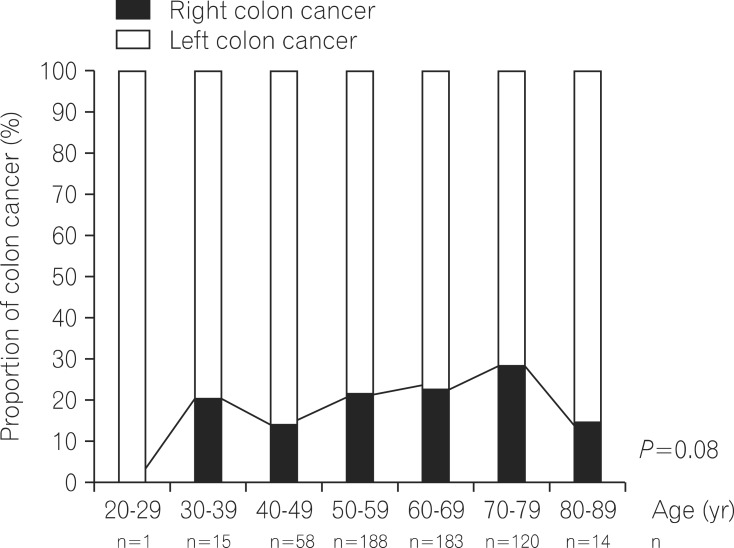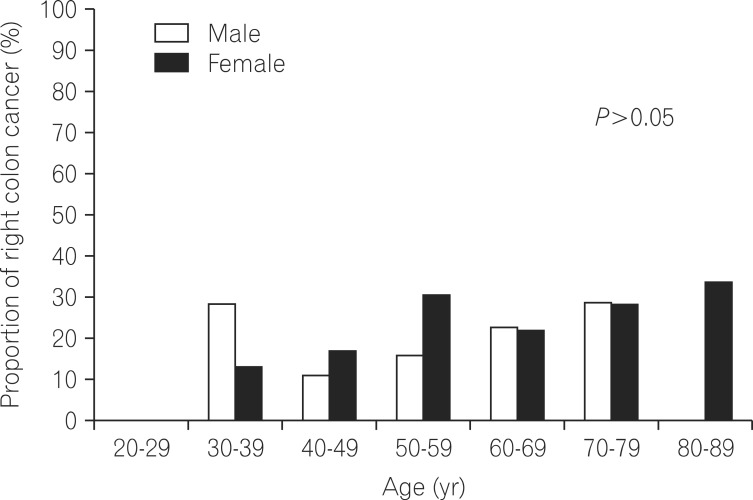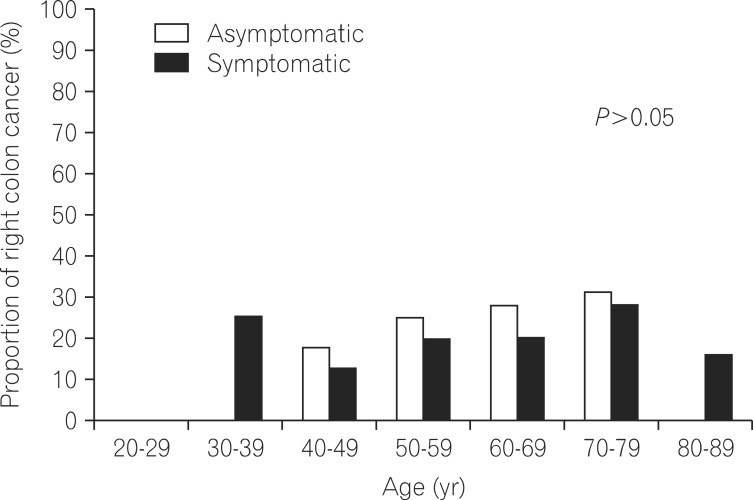Intest Res.
2014 Apr;12(2):131-138. 10.5217/ir.2014.12.2.131.
Clinicopathological Characteristics of Colon Cancer Diagnosed at Primary Health Care Institutions
- Affiliations
-
- 1SOK Sokpeynhan Internal Medical Network, Seoul, Korea. saintdamiano@hotmail.com
- 2SOK Sokpeynhan Internal Medical Network, Busan, Korea.
- 3SOK Sokpeynhan Internal Medical Network, Incheon, Korea.
- 4SOK Sokpeynhan Internal Medical Network, Incheon Gyeyang, Korea.
- 5SOK Sokpeynhan Internal Medical Network, Daegu, Korea.
- 6SOK Sokpeynhan Internal Medical Network, Deagu Sangin, Korea.
- 7SOK Sokpeynhan Internal Medical Network, Suwon, Korea.
- 8SOK Sokpeynhan Internal Medical Network, Ulsan, Korea.
- 9SOK Sokpeynhan Internal Medical Network, Cheonan, Korea.
- 10SOK Sokpeynhan Internal Medical Network, Pohang, Korea.
- 11SOK Sokpeynhan Internal Medical Network, Gumi, Korea.
- 12SOK Sokpeynhan Internal Medical Network, Daejeon Dunsan, Korea.
- 13SOK Sokpeynhan Internal Medical Network, Seodaejeon, Korea.
- 14SOK Sokpeynhan Internal Medical Network, Anyang, Korea.
- 15SOK Sokpeynhan Internal Medical Network, Uijeongbu, Korea.
- 16SOK Sokpeynhan Internal Medical Network, Pyeongtaek, Korea.
- 17SOK Sokpeynhan Internal Medical Network, Seongnam, Korea.
- 18SOK Sokpeynhan Internal Medical Network, Ilsan, Korea.
- 19SOK Sokpeynhan Internal Medical Network, Bucheon, Korea.
- KMID: 2284898
- DOI: http://doi.org/10.5217/ir.2014.12.2.131
Abstract
- BACKGROUND/AIMS
The purpose of this study was to evaluate the clinicopathologic characteristics of colon cancers detected at the SOK Sokpeynhan Internal Medical Network, a nationwide system of primary health care institutions.
METHODS
We analyzed 579 colon cancer patients diagnosed using colonoscopy at the SOK network from January 2011 through December 2012. Cancers from the rectum to the splenic flexure were classified as left colon cancer. Patients over 65 were classified as senior.
RESULTS
The mean age (+/-SD) of subjects was 60.9+/-10.5 years and 61.1% were men. More than one quarter (28.2%) of patients were asymptomatic. The prevalence of left colon cancer was higher (77.9%) than that for right colon cancer. The most frequent macroscopic and histologic types were depressed (58.9%) and moderately differentiated adenocarcinoma (52.2%), respectively. Asymptomatic subjects displayed protruding or well differentiated adenocarcinoma, while symptomatic patients were more likely to display depressed or moderately differentiated adenocarcinoma (P<0.05). The mean age of the right colon cancer group was higher than that for the left colon cancer group (P<0.05). Among symptomatic patients, the most frequent symptoms were bloody stool for patients with left colon cancer and abdominal discomfort for patients with right colon cancer (P<0.05). The prevalence of depressed cancer was higher in older subjects as compared to younger subjects (P<0.05). The prevalence of right colon cancer tended to increase with age, although this difference did not achieve statistical significance (P>0.05).
CONCLUSIONS
Study results indicated an increase of colon cancer amongst younger demographics in recent years. The effectiveness of colonoscopy screening was also evident, as asymptomatic patients demonstrated frequent findings of well differentiated adenocarcinomas. Study results also suggested a need for closer examination of older patients, as right colon cancer tended to increase with age.
MeSH Terms
Figure
Cited by 2 articles
-
Do Serrated Polyps Increase the Risk of Colorectal Cancer Development?
Su Hwan Kim, Ji Won Kim
Korean J Gastroenterol. 2016;67(3):161-163. doi: 10.4166/kjg.2016.67.3.161.Clinicopathological Characteristics of Newly Diagnosed Colorectal Cancers in Community Gastroenterology Practice
Chang Kyun Lee
Intest Res. 2014;12(2):87-89. doi: 10.5217/ir.2014.12.2.87.
Reference
-
1. Parkin DM, Bray F, Ferlay J, Pisani P. Global cancer statistics, 2002. CA Cancer J Clin. 2005; 55:74–108. PMID: 15761078.
Article2. Cancer Statistics in 2009. Cancer incidence [homepage on the Internet]. Goyang: National Cancer Institute;2012. cited 2012 Apr 11. Available from: http://www.cancer.go.kr/.3. Cho YK, Pyun YJ, Sung KC, et al. A study for The changing subsite distribution of colorectal cancer with age and sex. Korean J Gastrointest Endosc. 1997; 17:771–777.
Article4. Lee HL, Han DS, Jun DW, et al. Relationship between age and site of colorectal cancer based on colonoscopic findings. Korean J Gastrointest Endosc. 2004; 29:181–184.5. Lee HS, Lee S, Seo JH, et al. Characteristics of colorectal cancer in elderly patients in comparision with younger patients. Korean J Gastrointest Endosc. 2007; 34:76–82.6. Kim JY, Jang ES, Park SY, et al. Distinct characteristics of colorectal cancer and frequency of right colon cancer in elderly patients of Korea. J Korean Geriatr Soc. 2010; 14:147–154.
Article7. Kudo S. Early colorectal cancer: detection of depressed types colorectal carcinomas. 1st ed. Tokyo: Igaku-Shoin;1996.8. Hamilton SR, Aaltonen LA, editors. World Health Organization Classification of Tumours. Pathology and Genetics of Tumours of the Digestive System. 1st ed. Lyon: IARC Press;2000.9. Sabiston DC. Essentials of surgery. 1st ed. Philadelphia: WB Saunders Co;1987.10. Jung SA, Yang SK, Kang GH, et al. Clinicopathologic features and indication of endoscopic treatment of early colorectal cancer. Korean J Gastroenterol. 1998; 32:475–483.11. Whang IS, Park MH, Chon HJ, Lee SW, Ryu HS, Hyun JH. A clinical study on the carcinoma of the colon and rectum. Korean J Gastroenterol. 1987; 19:105–111.12. Lee JH, Nah YW, Suh BJ, Chang SH, Paik IW, Lee HS. Chronological changes of colorectal cancer. Korean J Gastroenterol. 1999; 33:51–57.13. O'Connell JB, Maggard MA, Liu JH, Etzioni DA, Livingston EH, Ko CY. Do young colon cancer patients have worse outcomes? World J Surg. 2004; 28:558–562. PMID: 15366745.14. Cooper GS, Yuan Z, Landefeld CS, Johanson JF, Rimm AA. A national population-based study of incidence of colorectal cancer and age. Implications for screening in older Americans. Cancer. 1995; 75:775–781. PMID: 7828127.
Article
- Full Text Links
- Actions
-
Cited
- CITED
-
- Close
- Share
- Similar articles
-
- The direction of reform for health care delivery system
- An Organization Theory Perspective on the Structural Reform of the Health Care Delivery System
- Treatment of Multiple Colorectal Cancers
- Characteristics of Colorectal Cancer Detected at the Health Promotion Center
- Hospital Admission Rates for Ambulatory Care Sensitive Conditions in South Korea: Could It Be Used as an Indicator for Measuring Efficiency of Healthcare Utilization?




